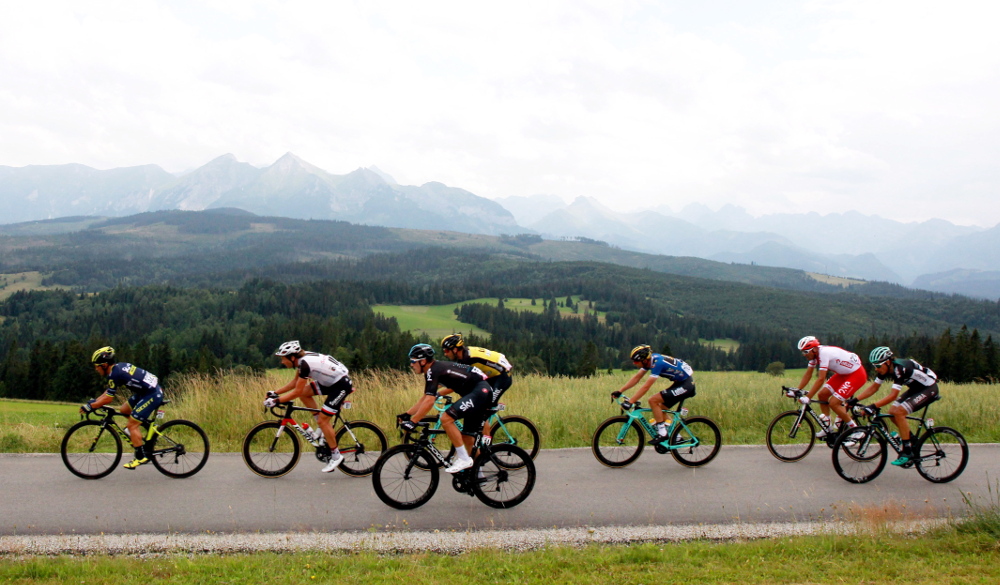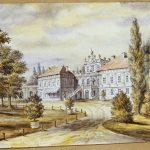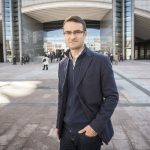THE WARSAW INSTITUTE REVIEW
Date: 12 March 2018 Author: Czesław Lang
Tour de Pologne – The Race that Started in Dreams
“We would like to present a proposal for you to write something for our journal The Warsaw Institute Review, in which you will explain the Tour de Pologne (Tour of Poland) phenomenon”, I was asked some time ago.

“An interesting challenge,” I thought. I glanced at the dictionary to remind myself of the terminology. A phenomenon is “a rare, remarkable person or thing.” Is the Tour de Pologne something like this? I do not want to judge the event that I am responsible for organizing, but I know that we have come a long way and we have in fact created something unique in Polish sport. I know that the Tour de Pologne is not just another sporting event, but something unique that connects people, attracts them to the race route or in front of televisions, and at the same time showcases Poland to the world.
I am not exaggerating: the race is broadcast in 130 countries and viewers see the beautiful parts of our country through their TV screens. Kraków, which is already very popular, strengthens its brand even more. Other regions can tell their story by showing their best side. This opportunity cannot be overestimated. If someone wants to translate this into monetary value, there is simply no cheaper and more effective means of promotion than through sport, especially cycling. For example, let’s look at Rio de Janeiro. Everyone associates this Brazilian with the carnival, the Christ the Redeemer statue, Copacabana, right? And yet, after the fantastically presented Olympic cycling race in 2016, I received a lot of calls from friends who were shocked at how stunningly beautiful Rio is. I also saw such reactions in online forums, and through other channels. All of this because hundreds of millions of people sat down in front of television sets to watch the best in the world compete, then in the process they saw something more – a fantastically beautiful environment. The Tour de Pologne is similar. Our race is more than just sport, but I will write more on that later.
Did I expect such success? I do not know, but I definitely dreamed about creating something great. When, as the first cyclist from our part of Europe, I made it to a professional peloton[1], I was as happy as a child, because I wanted to see a different, more colorful and better world. I went to Italy and competed with the best there. I observed the world’s largest events up close.
Ultimately, I stopped racing, although I could have probably extended my career. I already had other ideas, however. Of course, many cyclists try to organize their own teams. However, I thought that I would take a different road. A quarter of a century has just passed since the first Tour de Pologne for which I was responsible. Twenty-five years since, and yet I still remember everything exactly. Once, at the airport, I met the former director of the Tour de France. Jean-Marie Leblanc embraced me like a friend, though later he asked somewhat teasingly: “What’s up, Cesare? I hear you are planning to do an event like ours in Poland?” I said that it would not be the same, because we have our own beautiful history, which is worth showing to the world at the occasion of a great sporting event. I also added that I wanted the Tour de Pologne to be just as well-organized as the world’s biggest races. He looked at me and patted me on the back, but I did not notice great faith in his eyes. Besides, there were similar reactions everywhere. Anyway, it was similar a century ago.
When we organized the Tour de Pologne in 2016, the slogan of the event was “On the Trail of History”. I dug into the historical record. The Battle of Warsaw happened in 1920, but hardly anyone knows that those people who fought then at Radzymin, real patriots, later organized a cycling race. They turned to the French for help. The Tour de France already existed, so the French had experience. However, they wrote back to the Poles that they would be better off giving up the idea, because it was too difficult and they would certainly not be able to handle it. I can imagine what they felt…
When I took the wheel of the Tour de Pologne, it was the beginning of the 1990s, Poland had just broken free from communism, people were learning to live in a new reality and had a lot of problems on their minds. Above all, they wanted to secure the well-being of their families. When I met potential partners and said what I wanted to do, most only smiled. “Professional cycling? Mr. Lang, give me a break. Maybe in a few years,” they said. But I did not want to give up. I found partners, I invested my own savings, I started the project. And we made it. From the beginning, I followed certain rules. First of all, professionalism. I know that many will wince in a moment, but a quarter of a century ago I knew that a race is a product. It must have value, but also be beautifully packaged. The main protagonists must feel well taken care of, the media must broadcast everything appropriately, and the fans need to know that they are participating in something special. Of course, there have been and will be missteps, although the assumption is always the same: everything must be ready to the last detail.

Our race is often compared with the Tour de France. It is a fact that you can always find some common elements. Besides, we have nothing to be ashamed of, although at the same time it is worth remembering that it is hard to compare our budget with what they are capable of. We’re not complaining about anything, we’re doing fine, but sometimes I laugh, we entered the race in a Syrena (Polish car produced from 1957–1972) and we’re staying neck and neck with Formula 1 cars. We don’t lag behind in any way. After each season, we are judged by the bosses of world cycling and we get the same grades as the Tour de France or Giro d’Italia, and all elements are taken into account – from accommodations, through awards, to safety. We earn over 99 points out of 100.
Sometimes our inferiority complex annoys me, that if something is Polish, it is supposedly worse. This is not true, we can do great things, and at the same time we have fantastic fans. I remember 2016. Then, the Tour de Pologne was taking place in a difficult time. It overlapped with the Euro soccer championship, which attracts huge interest, and many fans were already waiting for the Olympics in Rio de Janeiro. However, the love for cycling won. On the route of our national track, three million fans watched the cyclists live. Millions more followed the competition in front of TVs. This is the biggest prize and the biggest measure of the success of our event. Then, after that race, I thought it was the realization of the goal that I set at the very beginning when I had only my dreams and a little savings. It was not about proving anything to anyone, but about dreaming to create something like that, a brand, that is recognizable all over the world, and guaranteed to be high quality. I remember a study carried out by Pentagon Research in 2013. It showed that the Tour de Pologne is the most recognizable annual sporting event in Poland. Statistically, more than four out of five respondents heard about the event organized by Lang Team. This is another measure of success.

In our country there is no bigger annual sporting event. Every day of the race, over twelve-hundred people are working on it and three-thousand secure it. Hundreds of vehicles travel the route ahead of, alongside and behind the cyclists. These people have to be ready for anything. I respect all sports disciplines and event organizers, but cycling is different from a soccer or volleyball game. There, everything happens in one place. Here, it’s just the opposite. I remember 2016 well. The mountain stage of the race took place in exceptionally difficult weather conditions. Rain was flooding the roads. In Zakopane we managed to make it, but in Bukowina Tatrzańska I had to make the decision to cancel the stage. There was no way out, although hundreds of people worked to make it possible to conquer the mountain roads, and the fans were waiting.
The most important thing, however, is safety. We’re constantly working on it. We have changed the type of fences separating fans from cyclists at the end of stages, and we are introducing other safeguards. I often think back to the Olympics in Rio. Annemiek van Vleuten was coming down from the last hill, riding for the gold medal, and she fell. She hit her head against a curb. Many fans thought that Dutch woman would not survive. My heart also stopped when this accident was shown on television. I knew that the cyclist could have killed herself and I was furious at the organizers. I did not understand how they could accept such amateurism in securing the route. During the Tour de Pologne, after overcoming the “royal loop”, there is an exceptionally sharp downhill ride from Gliczarów. The cyclists speed along at up to 100 kilometers per hour and suddenly have to overcome a sharp bend. Safety must be absolutely guaranteed in such places. We set out special nets there, similar to those in alpine skiing competitions, and we also line the curbs with mattresses. If someone falls, they’ll be saved.
During an event as high-profile as the Tour de Pologne, and in such a sport as cycling, you have to take care of everything. We’ve been learning this for years and we’re still learning because there are always new things and better solutions in every respect. At the same time, I feel that it is worth doing, because the race is successful. I always knew that Poles love cycling. I remember empty streets in the times of Ryszard Szurkowski and other celebrities of the Polish peloton when everyone was inside watching the races. I remember the Peace Race; which fans were very fond of. I did not have the ambition to repeat that success, but I knew what I wanted to create. I have already written of the fact that the race became a brand, which in turn is a showcase of Poland.
The next goal was to create many other events around the Tour de Pologne, which would permanently enter the landscape, and at the same time would have social and educational functions. We spent years creating the MTB Grand Prix series, in which Maja Włoszczowska and Ania Szafraniec were “brought up”. It was happening during a big boom in mountain biking. We “packaged” this event in an extraordinary way. There was television, the biggest media and huge interest, and athletes were fighting for the prize in the form of a new car. In some editions, a mass of kids took part. For years we have been developing other projects such as the Nutella Mini Tour de Pologne. Every year, I closely observe hundreds of kids who get shirts similar to those of the professional racers. In addition, they compete on the same route traveled by the “adult” peloton several hours later. I see the commitment, passion and joy on the faces of these children. This is the biggest prize. For years, this event was supported by my daughter Agata and she was also infected with passion and commitment. We are proud that everything has blossomed this way.
The next event, which “sprung up” at the Tour de Pologne, was the Amateur Tour de Pologne. An unusual event, though…not for everyone. To participate in it, it’s not enough to simply get up from behind the TV and start. I mean, it’s possible, but it does not bode well for success. Amateur cyclists conquer the “royal loop” around Bukowina Tatrzańska, and this is a really big challenge. However, the event has grown so much and is so popular that sign-ups start in January, and there aren’t enough places on the starting list for everyone. This is also a measure of success.
For a long time, I also wanted to help in education. This is how the idea of creating a series of cycling marathons was born. A decade or two ago, the bicycle was usually thought of as just a means of transportation. Later, everything changed and it became a tool used for physical activity and a healthy lifestyle. Bicycle paths were created, and sometimes I found myself in places where…bicycle traffic jams had formed. And, however annoying it might be, this sight made me realize how much everything is changing. Marathons have become a response to a social need. We gave the chance and opportunity for entire families to ride on various routes. There are distances for well-trained people, but also those on which you can ride with your child. On the routes I meet both small children and seniors. What more could you want?

None of this would have been possible without the right partners. It’s a huge job that needs to be done year-round. Cycling is a rewarding sport for advertisers, but you have to convince them to it. The family of Tour de Pologne partners is a really big one today and that is another reason to be proud. There are global brands with us, such as Carrefour or Hyundai, there are domestic giants like Lotto, Tauron or Lotos, there are many other companies and we strive to look after each of them as best we can.
There are also cities and local governments that understand better and better the opportunity that promotion through sport offers. We try to show the most beautiful places in our country in the best possible way. Shots from helicopters, motorcycles, continuous action, and beautiful spots in the background. This is how you “do” sports today and people appreciate it, because the Tour de Pologne reaches over one-hundred countries around the world, and in Poland it builds a sense of community and pride.
To understand this, you have to take part in it in any role, preferably as a fan. Therefore, there is nothing left for me to do but to invite everyone to the 75th Tour de Pologne, an exceptional race taking place in the year which marks the 100th anniversary of Poland regaining independence. We will celebrate a threefold jubilee: the 75th edition, ninety years since the first edition and finally, my humble anniversary of a quarter-century of taking responsibility for our national cycling event.
But this is not all, because I know that together, with fantastic fans and, above all, for them, we still want to develop the Tour de Pologne and everything that is happening around it. We are not going to stop; our heads are still full of ideas.
[1] The main body of riders in a cycling race.
All texts published by the Warsaw Institute Foundation may be disseminated on the condition that their origin is credited. Images may not be used without permission.














